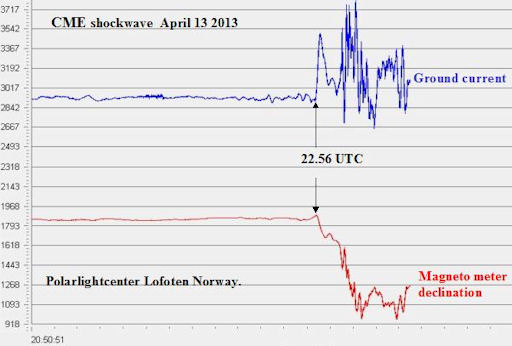SUNDAY EVENING PLANETS: When the sun sets on Sunday, April 14th, step outside and look west into the deepening twilight. The crescent Moon and Jupiter are in conjunction only a few degrees apart. It's a nice way to end the day. [sky map]
CME IMPACT: A coronal mass ejection (CME) swept past Earth on April 13th around 22:55 UT. The impact rattled Earth's magnetic field and induced electrical currents in the ground around the Arctic Circle. Rob Stammes recorded the effects of the impact from a geophysical monitoring station at the Polar Light Center in Lofoten, Norway:

"On my instruments there was a clear sugnature of the incoming coronal mass ejection," says Stammes. "The impact was not as strong as expected, but there were nice variations on my magnetometer and ground current instruments. There were also Northern Lights."
So far geomagnetic activity resulting from the impact has fallen short of storm levels, but this could change as Earth passes through the wake of the CME. High-latitude sky watchers should remain alert for auroras. on April 13-14. Aurora alerts: text, voice.
3D ANTI-CREPUSCULAR RAYS: Yesterday, near sunset, Larry Perkins was driving along highway I-25 north of Walsenberg, Colorado, when he saw a pair of dark rays lance across the sky. Using the motion of the car to change his perspective, he was able to photograph several stereo pairs. Cross your eyes to see the phenomenon in 3D:
The technical term for the phenomenon is "anticrepuscular rays"--that is, cloud shadows that point away from the setting sun.
"Slowly cross your eyes until the shadows merge," advises Perkins. "I find the shape of the lenticular cloud creating the rays as interesting as the rays themselves. The cloud is cylindrical and shrouded in a thin foggy shell."

![]()
Solar wind
speed: 462.5 km/sec
density: 14.7 protons/cm3
explanation | more data
Updated: Today at 1547 UT
![]()
X-ray Solar Flares
6-hr max: B5 1000 UT Apr14
24-hr: B6 0524 UT Apr14
explanation | more data
Updated: Today at: 1500 UT
![]()
![]()
![]()
Daily Sun: 14 Apr 13
![]()
![]()
Sunspots AR1718 and AR1719 have 'beta-gamma' magnetic fields that harbor energy for M-class solar flares. Credit: SDO/HMI
![]()
![]()
![]()
Sunspot number: 148
What is the sunspot number?
Updated 14 Apr 2013
Spotless Days
Current Stretch: 0 days
2013 total: 0 days (0%)
2012 total: 0 days (0%)
2011 total: 2 days (<1%)
2010 total: 51 days (14%)
2009 total: 260 days (71%)
Since 2004: 821 days
Typical Solar Min: 486 days
Update 14 Apr 2013
The Radio Sun
10.7 cm flux: 125 sfu
explanation | more data
Updated 14 Apr 2013
![]()
![]()
![]()
Current Auroral Oval:
![]()
Switch to: Europe, USA, New Zealand, Antarctica
Credit: NOAA/POES
![]()
![]()
![]()
Planetary K-index
Now: Kp= 2 quiet
24-hr max: Kp= 3 quiet
explanation | more data
![]()
Interplanetary Mag. Field
Btotal: 4.7 nT
Bz: 3.6 nT north
explanation | more data
Updated: Today at 1547 UT
![]()
![]()
![]()
Coronal Holes: 14 Apr 13
![]()
![]()
A coronal hole is emerging over the sun's SE limb. Solar wind flowing from the hole could reach Earth on April 20-21. Credit: SDO/AIA.





